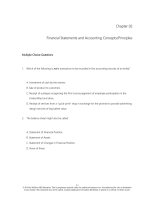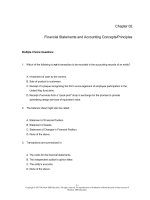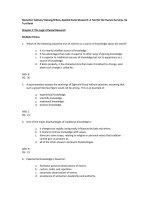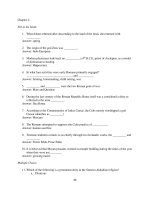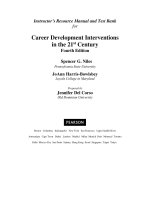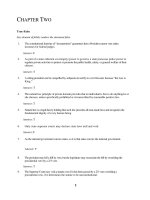Managers and the legal environment strategies for the 21st century 7th edition bagley test bank
Bạn đang xem bản rút gọn của tài liệu. Xem và tải ngay bản đầy đủ của tài liệu tại đây (379.18 KB, 14 trang )
CHAPTER 2
Ethics and the Law
TRUE FALSE QUESTIONS
1.
Compliance with the law is the baseline for effective and responsible managerial action.
ANSWER: True
SKILL LEVEL: Ethics
OBJECTIVE: AICPA: Legal
2.
Boycotting is a way in which customers show displeasure with unethical corporate activity.
ANSWER: True
SKILL LEVEL: Analytic
OBJECTIVE: AICPA: Legal
3.
From 1990 until today, the gap between what average workers make and what CEO’s of
companies make in the Standard and Poor’s Index has narrowed.
ANSWER: False
SKILL LEVEL: Analytic
OBJECTIVE: AICPA: Legal
4.
Ethics and law are unrelated.
ANSWER: False
SKILL LEVEL: Ethics
OBJECTIVE: AICPA: Legal
5.
The chief executive officer plays the most significant role in instilling a sense of ethics throughout
the organization.
ANSWER: True
SKILL LEVEL: Ethics
OBJECTIVE: AICPA: Legal
6.
Nobel Prize winner in economics Milton Friedman asserts that the only guiding criterion for the
corporation should be profitability within the confines of the law.
ANSWER: True
SKILL LEVEL: Ethics
OBJECTIVE: AICPA: Legal
7.
Employees are not stakeholders of a corporation.
ANSWER: False
SKILL LEVEL: Ethics
1
ETHICS AND THE LAW
2
OBJECTIVE: AICPA: Legal
8.
Legislatures in only a minority of the states have enacted statutes authorizing corporate boards to
take into account all stakeholders and constituencies even when a change in control or breakup of the
corporation has become inevitable.
ANSWER: False
SKILL LEVEL: Ethics
OBJECTIVE: AICPA: Legal
9.
Delaware has a constituency statute.
ANSWER: False
SKILL LEVEL: Ethics
OBJECTIVE: AICPA: Legal
10.
The two main schools of ethical thought are teleological and deontological.
ANSWER: True
SKILL LEVEL: Ethics
OBJECTIVE: AICPA: Legal
11.
Under the Teleological theory, the ethical good of an action is judged by the effect of the action on
others.
ANSWER: True
SKILL LEVEL: Ethics
OBJECTIVE: AICPA: Legal
12.
The Deontological theory focuses on the consequences of an action rather than on the motivation of
the individual.
ANSWER: False
SKILL LEVEL: Ethics
OBJECTIVE: AICPA: Legal
13.
Utilitarianism is a major deontological system that operates under the proposition that the ideal is to
focus on motivation rather than on consequences.
ANSWER: False
SKILL LEVEL: Ethics
OBJECTIVE: AICPA: Legal
14.
Utilitarianism seeks to equalize the benefit to everyone.
ANSWER: False
SKILL LEVEL: Ethics
OBJECTIVE: AICPA: Legal
CHAPTER 2
15.
ETHICS ANT THE LAW
3
As opposed to other forms of business, it is well accepted that the primary ethical and legal duty of
corporations is to maximize shareholder value.
ANSWER: False
SKILL LEVEL: Ethics
OBJECTIVE: AICPA: Legal
16.
Kantian theory considers universalizability and reversibility.
ANSWER: True
SKILL LEVEL: Ethics
OBJECTIVE: AICPA: Legal
17.
Rawlsian moral theory seeks to develop principles behind a “veil of information.”
ANSWER: False
SKILL LEVEL: Ethics
OBJECTIVE: AICPA: Legal
18.
Rawlsian moral theory seeks to maximize the condition of the worst off person in society.
ANSWER: True
SKILL LEVEL: Ethics
OBJECTIVE: AICPA: Legal
19.
Immanuel Kant argued that spending money in ways that are not consistent with shareholder wishes
is tantamount to imposing a tax and unilaterally deciding where the money will be spent.
ANSWER: False
SKILL LEVEL: Analytic
OBJECTIVE: AICPA: Legal
20.
If an action does not maximize shareholder value, and the firm has no ethical reason to act, the action
should not be taken.
ANSWER: True
SKILL LEVEL: Ethics
OBJECTIVE: AICPA: Legal
MULTIPLE CHOICE QUESTIONS
1.
Which of the following allows rights-based moral theories to be compared to other theories such as a
utilitarian framework?
A. Deontology
B. Teleological theory
C. Comparative justice
D. Rawlsian moral theory
ANSWER: C
SKILL LEVEL: Ethics
ETHICS AND THE LAW
4
OBJECTIVE: AICPA: Critical Thinking
2.
Which of the following is true regarding the relationship between law and ethics?
A. The law attempts to prohibit all “bad” behavior.
B. An action that is unethical is also considered illegal in the U.S.
C. Both that the law attempts to prohibit all “bad” behavior and that an action that is unethical is also
considered illegal in the U.S.
D. An action that is unethical may nonetheless be legal.
ANSWER: D
SKILL LEVEL: Ethics
OBJECTIVE: AICPA: Legal
3.
What was the result in the case of Bammert v. Don’s Super Valu, Inc., the case in the text involving
the alleged retaliatory firing by the defendant of the wife of a police officer after the officer arrested
the wife of the owner of Don’s Super Valu?
A. That the firing was prohibited because of the at-will employment principle.
B. That the firing was legal because of the at-will employment principle.
C. That the firing was prohibited because of a public policy exception to the at-will principle.
D. That the firing was legal because of the employment contract involved.
ANSWER: B
SKILL LEVEL: Analytic
OBJECTIVE: AICPA: Legal
4.
Which of the following are the three main theories under the comparative justice framework?
A. Retributive, Kantian, and Rawlsian
B. Compensatory, comparative, and retributive
C. Distributive, compensatory, and retributive
D. Utilitarianism, teleological, and compensatory
ANSWER: C
SKILL LEVEL: Ethics
OBJECTIVE: AICPA: Legal
5.
In 2010, the average CEO of a company in the Standard and Poor’s 500 Index took home more than
_____ times as much as the average worker.
A. 50
B. 100
C. 300
D. 500
ANSWER: C
SKILL LEVEL: Analytic
OBJECTIVE: AICPA: Legal
6.
Which of the following is a psychological disorder referenced in the text resulting in a lack of
empathy and the inability to recognize boundaries?
A. Prevalent personality disorder
B. Narcissistic personality disorder
CHAPTER 2
ETHICS ANT THE LAW
5
C. Corporate phenomena disorder
D. Trial disorder
ANSWER: B
SKILL LEVEL: Analytic
OBJECTIVE: AICPA: Legal
7.
Which of the following international organizations adopted a convention criminalizing bribes to
government officials and recommending a prohibition on the tax deductibility of bribes?
A. The Foreign Corrupt Practices Consortium
B. The Organization of Economic Cooperation and Development
C. The International Business Legal and Ethical Revision Association
D. Transparency International
ANSWER: B
SKILL LEVEL: Diversity
OBJECTIVE: AICPA: Legal
8.
Which of the following is true regarding the growth of socially responsible mutual funds?
A. Such funds have remained flat with little change in America, but they have grown significantly in
Europe.
B. Such funds have remained flat with little change in Europe, but they have grown significantly in
America.
C. Both America and Europe have seen a decline in interest in socially responsible funds.
D. Both America and Europe have seen growth in socially responsible funds.
ANSWER: D
SKILL LEVEL: Ethics
OBJECTIVE: AICPA: Legal
9.
Which of the following is the leading association of CEOs in the United States?
A. The Ethical Association of CEOs
B. The CEO Association of America
C. The Business Roundtable
D. The World Concern Association of CEOs
ANSWER: C
SKILL LEVEL: Analytic
OBJECTIVE: AICPA: Legal
10.
Under the “Ethical Business Leader’s Decision Tree” discussed in the text, which of the following is
the first question managers should ask themselves when determining whether a proposed action is
ethical?
A. Whether it will result in a loss of profits
B. Whether stockholders would approve
C. Whether the CEO would approve
D. Whether it is legal
ANSWER: D
SKILL LEVEL: Ethics
OBJECTIVE: AICPA: Legal
ETHICS AND THE LAW
6
11.
Which of the following is the group given the ultimate legal authority to change management?
A. Shareholders
B. Human resource managers
C. The mayor in the applicable jurisdiction
D. The city council in the applicable jurisdiction
ANSWER: A
SKILL LEVEL: Analytic
OBJECTIVE: AICPA: Legal
12.
Which of the following is a term for the maximization of shareholder value?
A. Shareholder importance
B. Shareholder primacy
C. Value of shares maximization
D. Corporate allocation
ANSWER: B
SKILL LEVEL: Analytic
OBJECTIVE: AICPA: Legal
13.
Which of the following is a term for a state statute authorizing boards of corporations to take into
account all stakeholders and constituencies even when a change in control or breakup of the
corporation has become inevitable?
A. Corporate control
B. Break-up
C. Constituency
D. Protection
ANSWER: C
SKILL LEVEL: Ethics
OBJECTIVE: AICPA: Legal
14.
In which of the following are a majority of Fortune 500 companies incorporated?
A. New York
B. California
C. Delaware
D. Connecticut
ANSWER: C
SKILL LEVEL: Analytic
OBJECTIVE: AICPA: Legal
15.
Which of the following is a stakeholder of a corporation?
A. Customers only
B. Employees and customers, but not managers
C. Managers and employees, but not customers
D. Customers, employees and managers
ANSWER: D
CHAPTER 2
ETHICS ANT THE LAW
7
SKILL LEVEL: Ethics
OBJECTIVE: AICPA: Legal
16.
Which of the following is true regarding shareholder primacy?
A. It is never legally mandated.
B. It is always legally mandated.
C. It is legally mandated only in very narrow circumstances.
D. There is no such thing.
ANSWER: C
SKILL LEVEL: Ethics
OBJECTIVE: AICPA: Legal
17.
Which of the following is recognized as the primary obligation of directors of a corporation?
A. That the obligation of the directors is to manage the corporation for the best interest of the
corporation.
B. That the obligation of the directors is to manage the corporation for the best interest of the
officers.
C. That the obligation of the directors is to manage the corporation for the best interest of the
employees.
D. That the obligation of the directors is to manage the corporation for the best interest of the
community.
ANSWER: A
SKILL LEVEL: Ethics
OBJECTIVE: AICPA: Legal
18.
Nobel prize winner Milton Friedman asserts that “social responsibility” is a fundamentally
____________ doctrine.
A. positive
B. risky
C. good
D. subversive
ANSWER: D
SKILL LEVEL: Ethics
OBJECTIVE: AICPA: Legal
19.
Which of the following illustrates that corporate conduct violating society’s expectations can result in
new forms of regulation without regard for feasibility or cost?
A. The White-Rush Dow Jones Conciliatory Act of 2011
B. The Dodd-Frank Wall Street Reform and Consumer Protection Act of 2010
C. The Corporate and Securities Reform and Retribution Consumer Protection Act of 2011
D. The Securities and Oversight Act of 2009.
ANSWER: B
SKILL LEVEL: Ethics
OBJECTIVE: AICPA: Legal
20.
Which of the following statements regarding the teleological theory is false?
ETHICS AND THE LAW
8
A. Teleological theory is concerned with consequences.
B. Teleological theory judges the ethical good of an action by the effect of the action on others.
C. Teleological theory focuses more on the motivation and principle behind an action.
D. Both that teleological theory is concerned with consequences and that teleological theory judges
the ethical good of an action by the effect of the action on others.
ANSWER: C
SKILL LEVEL: Ethics
OBJECTIVE: AICPA: Legal
21.
Rawls believed that social policies developed behind the veil of ignorance would create a system that
most benefits the
A. Majority
B. Minority
C. Least well off
D. Most well off
ANSWER: C
SKILL LEVEL: Ethics
OBJECTIVE: AICPA: Legal
22.
According to the Kantian theory of universalizability, the ethical worth of an act is determined by
whether one
A. would want such a rule applied to minority members of society
B. would want everyone to perform in this manner
C. could get away with such an action
D. could live with the results of such an action
ANSWER: B
SKILL LEVEL: Ethics
OBJECTIVE: AICPA: Legal
23.
Which of the following is part of Kant’s categorical imperative?
A. The form of an action rather than the intended result determines the ethical worth.
B. No one person’s interest is given more weight than another.
C. Distribution favors the person getting the worst share.
D. Both that no one person’s interest is given more weight than another and that distribution favors
the person getting the worst share.
ANSWER: A
SKILL LEVEL: Ethics
OBJECTIVE: AICPA: Legal
24.
Which of the following is not an example of St. Thomas Aquinas’ requirements for a law to be just?
A. The law must be within the power of individuals to fulfill it.
B. The law must be consonant with a reasoned determination of the universal good.
C. The law must be formed to promote a private benefit to the majority.
D. The law must be widely promulgated.
ANSWER: C
CHAPTER 2
ETHICS ANT THE LAW
SKILL LEVEL: Ethics
OBJECTIVE: AICPA: Legal
25.
Which of the following plays the most significant role in instilling a sense of ethics throughout an
organization?
A. The CEO
B. The human resources manager
C. Each employee’s immediate supervisor
D. The employees themselves
ANSWER: A
SKILL LEVEL: Ethics
OBJECTIVE: AICPA: Legal
26.
According to St. Thomas Aquinas, the only true laws were those that followed ____________.
A. reasoned law
B. customary law
C. eternal law
D. localized law
ANSWER: C
SKILL LEVEL: Ethics
OBJECTIVE: AICPA: Legal
27.
Which of the following is true regarding the Organization of Economic Cooperation and
Development (OECD)?
A. It is comprised of nations form North America, Europe, and Asia-Pacific.
B. It is a subsidiary of the European Union.
C. It is comprised of nations who entered into the North American Free Trade Agreement.
D. It is comprised of states inside the U.S.
ANSWER: A
SKILL LEVEL: Diversity
OBJECTIVE: AICPA: Legal
28.
According to the Delaware Supreme Court, when does the role of a director shift from being a
“protector of the corporate bastion” to being an “auctioneer” charged with obtaining the highest
realizable short-term value for the shareholders?
A. Only when the breakup of the corporation or a change of control has become inevitable
B. Whenever a yearly loss is reflected
C. At the point that a yearly loss has been reflected for three straight years
D. When the CEO and the board of directors are in disagreement, and there has also been a yearly
loss reflected for three straight years
ANSWER: A
SKILL LEVEL: Analytic
OBJECTIVE: AICPA: Legal
Fact Pattern 2-1 (questions 29-30 apply)
9
ETHICS AND THE LAW
10
Susan is an accountant who works in a company owned by Richard. Richard is concerned about the
amount of taxes he will owe for the year and asks Susan to falsify his income tax return. Susan
refuses. Richard fires her. Susan asks you for advice telling you that Richard is unethical and that
she is certain that the law prohibits all unethical conduct.
29. Refer to fact pattern 2-1. Which of the following is the theory on which Richard will most likely rely?
A. The employer-freedom principle
B. The employment-at-will principle
C. The free-country theory
D. The free-market theory
ANSWER: B
SKILL LEVEL: Reflective Thinking
OBJECTIVE: AICPA: Critical Thinking
30.
Refer to fact pattern 2-1. Which of the following is a theory on which Susan may be able to prevail?
A. Public policy
B. Reflective policy
C. Implied protection
D. No justification
ANSWER: A
SKILL LEVEL: Reflective Thinking
OBJECTIVE: AICPA: Critical Thinking
Fact Pattern 2-2 (questions 31-32 apply)
Jack decides to donate leftover food from his restaurant to a homeless shelter. Brock, an employee
who was angry with Jack over not getting a raise, claimed that Jack decided to donate the food only
for publicity and that Jack did not really care about homeless people. Peggy, another employee
disagreed, contending that regardless of his motivation, Jack was acting ethically because of the
consequences involved and the number of people helped.
31.
Refer to fact pattern 2-2. Upon which of the following would Jack most likely rely in contending
that he donated the food because he was motivated to help the poor?
A. Rawlsian moral theory
B. Teleological theory
C. Artificial person application
D. Deontological theory
ANSWER: D
SKILL LEVEL: Reflective Thinking
OBJECTIVE: AICPA: Critical Thinking
32.
Refer to fact pattern 2-2. Upon which of the following would Peggy most likely rely to support her
contention?
A. Rawlsian moral theory
B. Teleological theory
C. Artificial person application
D. Deontological theory
CHAPTER 2
ETHICS ANT THE LAW
11
ANSWER: B
SKILL LEVEL: Reflective Thinking
OBJECTIVE: AICPA: Critical Thinking
Fact Pattern 2-3 (questions 33-34 apply)
Wally and Janice are both managers in a small corporation set up to manufacture sporting goods.
They both receive bonuses for any ideas that benefit the company, although Janice’s bonus is
computed at a lower rate than Wally’s because she has been at the company a shorter amount of time.
Janice has a great marketing idea that would result in her receiving a bonus of $1,000. She has it all
worked out on her computer. Unknown to her, one evening after business hours, Wally obtains the
information from her computer and submits it himself the next day. He is immediately awarded a
bonus of $2,000 for the information. Fortunately for Janice, Sally, a custodian, saw Wally in Janice’s
office and heard him calling his wife while he was there to brag about his misdoings. Sally informed
Blaire, the CEO, of Wally’s actions.
33.
Refer to fact pattern 2-3. Which of the following types of justice is involved if Blaire requires that
Wally give Janice $1,000?
A. Compensatory
B. Retributive
C. Fair
D. Justifiable
ANSWER: C
SKILL LEVEL: Ethics
OBJECTIVE: AICPA: Critical Thinking
34.
Refer to fact pattern 2-3. Which of the following types of justice is involved if Blaire requires that
Wally give Janice the entire $2,000 bonus he received?
A. Compensatory
B. Retributive
C. Fair
D. Justifiable
ANSWER: B
SKILL LEVEL: Ethics
OBJECTIVE: AICPA: Critical Thinking
35.
Monica tells all her employees that she expects them to treat others as they would like to be treated.
Which of following is a descriptive term for Monica’s requirement?
A. The Required Rule
B. The Accepted Rule
C. The Golden Rule
D. The Advanced Rule
ANSWER: C
SKILL LEVEL: Ethics
OBJECTIVE: AICPA: Critical Thinking
ETHICS AND THE LAW
12
ESSAY QUESTIONS
1.
Art, the sole shareholder of ABC Company, got a ticket for reckless driving because he was speeding
through a school zone at 85 miles per hour. Sue, the wife of the officer who gave Art the ticket, was
an employee of ABC Company. Art asked her if she could get the ticket “fixed” for him. Sue indeed
talked to her husband, but he was unwilling to tear up the ticket. Art was incensed and fired Sue on
the spot saying that she could not be counted upon to do anything the right way. Discuss the pros
and cons of whether Sue should prevail in an action against ABC Company alleging a violation of
public policy.
ANSWER: The facts are similar to those in Bammert v. Don’s Super Value, Inc. discussed in the
text. Students should discuss fairness in employment versus the employment-at-will doctrine.
SKILL LEVEL: Reflective Thinking
OBJECTIVE: AICPA: Critical Thinking
2.
Discuss and explain the ethical business leader’s decision tree referenced in the text.
ANSWER: Students should discuss the questions presented in the decision tree such as whether a
proposed action is legal, whether it maximizes shareholder is value, and whether the action is ethical.
SKILL LEVEL: Ethics
OBJECTIVE: AICPA: Legal
3.
Set forth the ways described in the text in which ethics and law are related.
ANSWER: (1) A judge or jury’s assessment of the ethical character of an action may determine how
the law is interpreted and applied in a given case, (2) law often reflects society’s consensus about
what constitutes appropriate behavior; (3) law can help define the roles managers play, how they
play those roles, and whether they have played them well; (4) patterns of unethical behavior tend to
result in illegal behavior over time; and (5) unethical conduct tends, over time, to lead to more
onerous business regulation.
SKILL LEVEL: Reflective Thinking
OBJECTIVE: AICPA: Critical Thinking
4.
You are the owner of a small Internet company. You are planning a public offering in 12 months.
You ask your accountant to prepare an optimistic business model that shows a greater profitability
potential than a conservative estimate would produce. When the accountant questions your
profitability assumptions, you remind him that he has been given 10,000 shares of the company stock
at a low price. A public offering would dramatically increase the value of those shares. Discuss the
ethical issues faced by the owner and the accountant. How should they be resolved?
ANSWER: The ethical business leader’s decision tree should be consulted. An action that is illegal
should not be performed. Assuming illegality is not involved, other considerations are whether
shareholder value is maximized; and, if not, whether it is ethical to perform the action. It appears
that bribery may be involved. If the optimistic business model would be inaccurate, the owner
should withdraw the request; and the accountant should refuse to provide an inaccurate model.
SKILL LEVEL: Reflective Thinking
OBJECTIVE: AICPA: Critical Thinking
5.
Your company has asked you to write a code of ethics. What should you include and why?
CHAPTER 2
ETHICS ANT THE LAW
13
ANSWER: Many examples are reported in the text of situations in which companies encountered
difficulties due to unethical conduct. Students should set forth rules guarding against unethical as
well as illegal conduct.
SKILL LEVEL: Ethics
OBJECTIVE: AICPA: Legal
6.
Your company has grown from a national to a multi-national entity. How have your ethical
responsibilities changed? To whom do you owe these responsibilities?
ANSWER: As the text makes clear in the section titled “When Ethics Travel,” practices regarded as
ethically unacceptable in the United States may be common practice in foreign countries. Students
should discuss the fact that ethical responsibilities are owed to all affected including citizens and
employees of a host country.
SKILL LEVEL: Diversity
OBJECTIVE: AICPA: Critical Thinking
7.
You are the CEO of a multi-billion dollar company. Your company employs over 75,000 people. The
company is being sued for $100 million dollars as the result of racial discrimination against your
customers. Your investigation reveals that some of your managers are actively violating the law.
Discuss the steps you would take to ensure your company’s compliance with ethical norms and legal
requirements.
ANSWER: Students should discuss the need for an ethical code of conduct and the need to take
immediate action to end the discrimination, including discharge of those responsible if needed.
SKILL LEVEL: Reflective Thinking
OBJECTIVE: AICPA: Critical Thinking
8.
Discuss why Enron failed and who should be held responsible for the failure.
ANSWER: Students should discuss improper accounting practices, questionable information
provided to Wall Street investors and the public; wrongful actions by managers; and the wrongful use
of partnerships.
SKILL LEVEL: Reflective Thinking
OBJECTIVE: AICPA: Critical Thinking
9.
List the two main schools of ethical thought and their main focus.
ANSWER: The two main schools of ethical thought are teleological and deontological.
Teleological theory is concerned with consequences. Under teleological theory, the ethical good of
an action is to be judged by the effect of the action on others. Deontological theory focuses more on
the motivation and principle behind an action than on the consequences.
SKILL LEVEL: Ethics
OBJECTIVE: AICPA: Legal
14
ETHICS AND THE LAW
